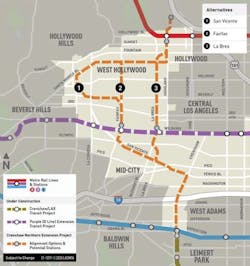Three routes recommended for further study on Crenshaw Northern Extension project
Three possible routes will be considered by the Los Angeles County Metropolitan Transportation Authority's (L.A. Metro) Board of Directors for the Crenshaw Northern Extension Project, as well as a $50.3-million contract for environmental analysis and advanced conceptual engineering of the project.
Five potential routes were studied in the project’s Feasibility/Alternatives Study that was released in 2018. After further analysis and public review, the three routes recommended for further study were identified as the ones that had the most public support, highest potential ridership and were the most practical and cost effective.
A potential extension from Hollywood/Highland Station to the Hollywood Bowl will also be studied. The Bowl is about a one mile walk from the current Red Line station. L.A. Metro says getting rail transit to the Bowl has long been talked about but has proven difficult due to the high cost of building transit to a destination that gets large crowds.
The 8.5-mile Crenshaw/LAX Transit Project is currently being constructed between the C Line (Green) and the E Line (Expo). The Crenshaw Northern Extension would continue the Crenshaw/LAX Line to the north to a transfer point with the Purple Line subway and then continue to the Red Line subway in Hollywood.
In addition to forging faster transit connections between communities south and north of the 10, the project could also serve busy job and commerce centers north of the 10 freeway, including the Wilshire Corridor, West Hollywood and Hollywood. Early ridership estimates for all the routes were very promising, showing about 90,000 boardings being taken on the line on weekdays, says L.A. Metro.
The Measure M spending plan provides about $2.2 billion for the project, although early cost estimates show that the expected cost could be significantly more due to expected tunneling and bridges that could be needed. Under Measure M, the project is scheduled to be built in the 2040s. But L.A. Metro — in partnership with the city of West Hollywood and the city of Los Angeles — is advancing planning work on two key conditions. One is that funding can be found to accelerate the project, and two, that accelerating the project would not impact the timelines of other Measure M projects, as per L.A. Metro’s project acceleration policy.
Although the analysis and engineering contract being considered by the L.A. Metro Board is for $50.3 million, only $2.2 million of that would be spent in fiscal year 2021 in order to contain costs during the ongoing coronavirus pandemic. If approved, the contract will be awarded once the board approves a budget for L.A. Metro for the current fiscal year. L.A. Metro pushed back its budget approval from May to September in order to reflect costs related to the ongoing pandemic.
The L.A. Metro Board’s Planning Committee is scheduled to discuss the item as part of their meeting on Aug. 19.
